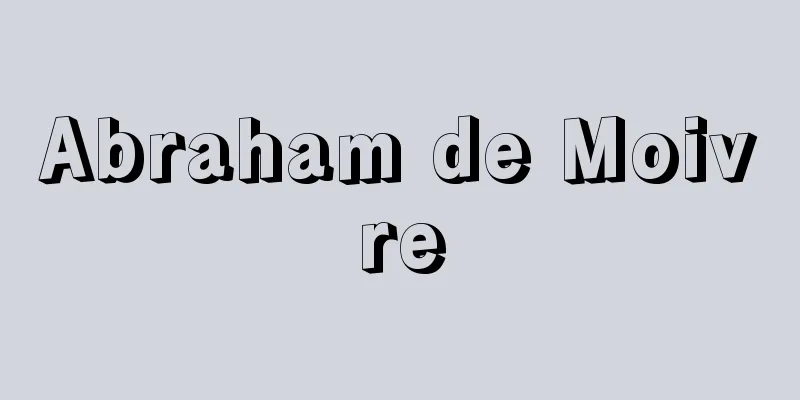Renaissance - Renaissance (English spelling)

|
This concept has traditionally been used as a catch-all term to describe the change in lifestyle and thinking from the Middle Ages to the modern era, but doubts are now being raised as to whether this is an appropriate term to use in that sense. [Koichi Horikoshi] The Origin of the Term RenaissanceAt the turn of the 17th century, Antoine Furtière's second edition of the Dictionary Universal (1701) and Pierre Bayle's Dictionary Historia Critica (1697) both included the term "Renaissance". The former registered the term "Renaissance of Art", while the latter established the term "Renaissance of Letters". Both definitions confirmed the views of 16th century humanists. In the mid-16th century, Italian painter Giorgio Vasari pointed out the "Rinascita (rebirth) of art" in his book "Biographies of the great Italian architects, painters, and sculptors, from the time of Cimabue to our time" (1550). He spoke of the results of Italian painters' study of the ancient art styles and their training in the depiction of nature from the 14th to the 16th centuries. Around the same time, the French humanist Jacques Amiot, in his dedication to Henry II of his French translation of Plutarch's Parallel Lives (1559), mentioned that "literature was reborn." In this case, Amiot had in mind the founding of the Collège de France by Francis I. That is, the understanding of the "Literary Renaissance" at that time was focused on the study of classical languages and ancient writings. The revival of ancient arts and the arts and sciences was what humanists in Italy from the 15th century onwards, and in Northern Europe from the 16th century onwards, thought of the "Renaissance." The Enlightenment of the 18th century gradually shaped the view that the "Renaissance" was a period. This was related to the issue of the Middle Ages and modern times, and the "Renaissance" was seen as the beginning of the enlightened modern era. In his writings such as "Discourse on Manners and Manners," Voltaire basically understood the "Renaissance" to mean the revival of ancient arts and sciences, based on the understanding of previous eras, but he also saw it as an escape from the "Middle Ages," and envisioned "Enlightenment" and "improvement of political and social life." Another of Voltaire's insights was that he pointed out the excellence of Italian society in this trend from the late 15th century to the 16th century. The 19th century bourgeoisie, who had eventually achieved the civil revolution, conceived of the Renaissance as the period when modern civil society would be established. This opened up the possibility that the Renaissance, which was a limited concept of the study of ancient arts and sciences, could be developed into a concept of an era. [Koichi Horikoshi] Renaissance in ItalyIt was Swiss historian Jacob Burckhardt who took a holistic view of the Renaissance as a period concept. His book The Culture of the Renaissance in Italy was published in 1860. This book is an essay that attempts to see a unique type of society and culture in Italy in the 14th, 15th, and 16th centuries. Burckhardt was careful to limit time and space, and phrases such as "first in Italy," "in Italian society during the Renaissance," and "where else but Italy" appear throughout the book. Burckhardt was specific about the "culture of the Renaissance in Italy" as the subject of his study. Therefore, when he discusses "the revival of antiquity" (the title of the third chapter) and writes that "since the beginning of the 14th century, generations of great poets and philologists have filled Italy and the world with the worship of antiquity," he is betraying himself. The "and the world" in "Italy and the world" was an unnecessary and careless remark in light of the original purpose of the work. In this regard, the position of contemporary French historian Jules Michelet is interesting. Michelet, who published "The Renaissance", the 7th volume of "History of France" (the 9th volume in the definitive edition published in 1881), in 1855, rejected the idea of an "Italian Renaissance", but on the other hand praised the "discovery of man and the world" as the achievement of 16th century European society in general, and named it the "Renaissance". For Michelet, the "Renaissance" was not simply the revival of the ancient arts and sciences as the humanist tradition called it, nor was it a cultural movement that was limited to Italian society from the 14th to the 16th century, as wisely limited by Burckhardt. The "Renaissance" that Michelet spoke of was the momentum of modernization of European society. This Micheletian perspective was based on the lineage of Enlightenment thinking that had been around since Voltaire. From the humanist's point of view, it was a case of shifting the issue around. "The Discovery of Man and the World" is also the title of one of Burckhardt's books. Burckhardt, too, used modern keywords such as man and world, individual and nation to examine Italian society at that time, and naturally his own perspective was established in his work. And that perspective was that of Michelet, and by extension, that of 19th century civil society. As for books that have discussed the Italian Renaissance since Burckhardt, the first one that must be mentioned is John A. Symons's The Italian Renaissance, a set of seven volumes (1875-86). The first volume is titled "The Age of Tyrants." This corresponds to the first chapter of Burckhardt's book, "The State as a Work of Art," and as can be clearly seen there, Symons' writing is a careful repetition of Burckhardt's book. However, the tone of the argument is more similar to that of Michelet or Hegel (the arguments found in "Philosophy of History" and "History of Philosophy"). This is clear in passages such as "The Renaissance was the release of the reasons why the modern world should exist." From Burckhardt to Symons, the tone of the Renaissance discussion has been the same. It is a method of reading a universal value system into the specific historical space of "Renaissance Italy." It can also be called the "central idea." The idea is that the "Italian Renaissance" liberated modern Europe, and that the entire modern value system has its origins in Italy. [Koichi Horikoshi] Northern RenaissanceNaturally, the "ideology of the periphery" is opposed to this, and this is the "Northern Renaissance" argument. Or it is one aspect of the "Northern Renaissance" argument. On the one hand, in literary history, as represented by Gustave Ranson's "History of French Literature" (1894), there is a viewpoint that sees the French Renaissance as a successor to the Italian one, and on the other hand, in parallel with this, the emphasis on the position of the periphery is also understood to be included in the phrase "Northern Renaissance". The latter argument is particularly prominent in the field of art history, and the names of Louis Courageau and his predecessor Hippolyte Vierens Heverd must be mentioned. Courageo's Lectures at the École du Louvre (1887-96) (published posthumously between 1899 and 1903) discusses how 14th-century northern French art, characterized by individualism and naturalism, was absorbed into the Burgundian cultural sphere in the 15th century, fostering the Netherlandish school of painting and exerting an influence on Italian painters in the latter half of the century. Belgian author Vierens Heverd's Northern Renaissance and the Early Netherlandish School (1905) is a careful reiteration of Courageo's arguments, and the title of this work is thought to have established the phrase "Northern Renaissance" in art history. The understanding of the "Northern Renaissance" is also dualistic in the fields of literary and intellectual history. In this field, the "Renaissance" is on good terms with "Humanism" and "Reformation," but for the Frenchman Henri Hozé, humanism was nothing other than an Italian phenomenon that began with Petrarch and that France imported ("On Humanism and the Reformation in France," Ruby Historique, 1897). For the German Ludwig Geiger, the "Renaissance" followed Burckhardt's definition, and "barbaric Germany" became its successor ("Renaissance and Humanism in Italy and Germany," 1882). On the other hand, Paul Joachimsen judged Renaissance humanism to be an original Italian trend, and sought to understand German humanism on its own national basis. In Germany, antiquity was sought elsewhere (Historical Understanding and Writing in Germany under the Influence of Humanism, 1910). According to Conrad Burdach, the consciousness of the "Renaissance" was first and foremost religious, inspired by the mysticism of the Franciscans in the 13th century. In Italy, it gave birth to the restorationist movement of Cola di Rienzi, which aimed to return to the Roman Republic, and then followed a secularizing direction, but already at this point, the consciousness of the "Renaissance" that branched out into Germany through the court of the Bohemian royal family strengthened its religious character and led to the "Reformation." The "German Renaissance" naturally had a different basis of manifestation from the "Italian Renaissance" (The German Renaissance, 1916). Britain was strangely naive in this regard. It lacked the idea of a "Renaissance of its own." Generally speaking, it was cold toward the idea of the "Renaissance" itself. It was merely one of the many stimuli that came from the outside. The whole world was not preoccupied with the "Renaissance" debate. [Koichi Horikoshi] Middle Ages and RenaissanceBurckhardt's term "Renaissance" was freed from the spatial limitations of Italy and came to be used to describe the mood of European society as a whole. On the other hand, the liberalization also progressed in time, and the origins of the "Renaissance" were endlessly sought deep within the medieval world. This is called the "Renaissance Digging Theory." It is not so much a statement that one can see "precursors" here and there. Heinrich Thode's Francis of Assisi and the Beginnings of Renaissance Culture in Italy (1885) is expressive. The title of the book makes it clear. "One goes back to the Middle Ages to find forms and movements that seem to bear the stamp of the Renaissance," Johan Huizinga wrote in The Autumn of the Middle Ages. The book was published in 1919, but just before that, in a lecture at the Sorbonne in 1913, Henri Chamard sought the origins of the "French Renaissance" in the "spirit of the goal" and the "courtly civility." The Romance of the Rose and the "Grand Rhetorician" bridged the Middle Ages to the "Renaissance" (The Origins of French Renaissance Poetry, 1932). Or Kunno Franke's Personality in Pre-Luther German Literature (1916) sees the first manifestation of "Renaissance personality" in the Minnesenger of the 12th and 13th centuries. It seems impossible to read Schamard and Franke as questioning the connection between medieval culture and the "Renaissance." They see the "Renaissance" in medieval culture itself. The spell of Burckhardt's "Renaissance" remains strong. That is why Huizinga continues, "The concept of the Renaissance has become so stretched that it has become completely inflexible." Things from the Middle Ages should be returned to the Middle Ages. Wallace K. Ferguson, an American author of The Renaissance in Historical Thinking (1948), which surveyed the post-humanist debate on the "Renaissance," titled his final chapter "The Medievalist Revolt: The Renaissance Explained as a Continuation of the Middle Ages," commented that the problem was that too little was known about medieval culture. From the beginning of the 20th century, knowledge of the Middle Ages was rapidly expanded and deepened. There was enough material available to properly evaluate the "Renaissance" movement in medieval culture, which led Charles H. Haskins to write The Twelfth Century Renaissance (1927). The shift in perspective in art history is striking. The Germans Wilhelm Wallinger (1908) and Heinrich Wölfflin (1915) clarified the uniqueness of medieval art in terms of style, pointing out the meaninglessness of casually applying the standards of "Italian Renaissance art" to the Middle Ages or any other period. On the other hand, the French Émile Mahle opened up a perspective on the tradition of naturalism in medieval art in a series of writings beginning with Sacred Art in the 13th Century in France (1898). The Austrian Max Dvorak elucidated the issue of naturalism in medieval art in relation to the spiritual situation of the Middle Ages ("Idealism and Naturalism in Gothic Sculpture and Painting," Historische Zeitschrift, 1918). [Koichi Horikoshi] The Ideal RenaissanceIn the conclusion of his book The Autumn of the Middle Ages (1919), subtitled "A Study of the Forms of Life and Thought in France and the Low Countries in the 14th and 15th Centuries," Huizinga writes, "The Renaissance only comes when the rhythm of life changes." He is stating that France and the Low Countries in the 14th and 15th centuries were not yet in the season of the "Autumn of the Middle Ages," and this is the first main point of this book. It can also be read as saying that if the "rhythm of life" had changed after this, it would be fair to criticize that the "Renaissance" had arrived, and this is the second main point. In other words, Huizinga was not at all opposed to the conventional understanding of the "Renaissance." He simply reported his impression, based on his observations, that the historical space of "the 14th and 15th centuries in France and the Low Countries" was still the Middle Ages, by setting a time and space. The crucial point is that here we can clearly see an attitude returning to Burckhardt, and this is the essence of Huizinga's criticism of the "Renaissance" debate. After the publication of The Autumn of the Middle Ages, Huizinga made active proposals in essays such as "The Problem of the Renaissance" (1920) and "The Renaissance and Realism" (1929) in which he spoke of the need to optimize the concept of the "Renaissance". However, Huizinga's greatest contribution to the problem of the "Renaissance" was precisely in The Autumn of the Middle Ages itself, that is, to observe the transition from the Middle Ages to modernity in the reality of life, in the state of thought and sensibility, within a limited time and space. This was the aim of this book. For example, research on the 16th century Netherlands and France, or shifting the time to the 14th and 15th centuries, Germany, for example, and various other individual spaces, following the example of Burckhardt and Huizinga, is expected. It may be possible to draw a complete picture of the "Renaissance" through the accumulation of such work. The "Renaissance" will no longer be a humanist nostalgia. It cannot be a mirror image of 19th century civil society, nor can it be an idol imbued with modern values, but rather a definite picture of the various aspects of continuity and change from the Middle Ages to modern times. [Koichi Horikoshi] Current status of the Renaissance debateThere is no doubt that the "Italian Renaissance" was a part of that picture, and a very important part at that. What is important is to observe the pattern, and the collection of essays entitled "Italian Itinerarium" published in 1975, half a century after "The Revolt of the Medievalists," is a report of this painstaking work. This is a collection of essays dedicated to Paul O. Kristeller, a great scholar known for his research on Italian humanism, and its subtitle is "Profile of the Italian Renaissance Reflected in the Mirror of the Transformation of Europe." The "transformation of Europe" referred to here can be understood as "Renaissance" in a broad sense. In other words, it is a pattern woven together by aspects of continuity and change from the Middle Ages to modern times. The "Italian Itinerarium" can be seen there. In other words, it is the footprint of the "Italian Renaissance" ("Italian Itinerarium" is a Latin word meaning "on the way" or "guidance," and in this sense the title of the book can also be translated as "The Italian Way"). The conventional practice of understanding the "transformation of Europe" referred to here as the "Renaissance" in a broad sense must be respected. However, as one of the contributors to this collection, the Dutch scholar Sem Dresden, points out, it is important to note that the concept of "Mannerism" has recently been raised in relation to the spiritual situation of 16th-century Europe. Dresden's essay in this collection is called "Profile of the Reception of Italian Renaissance in France" and mainly focuses on 16th century French humanists and writers. He argues that words such as "natura (nature)," "ars (arts)," "imitation," or "essay" (trial or training), which Montaigne used as the title of his work, and especially "maniera" are effective in elucidating the spirit of writers who have traditionally been introduced within the framework of "Renaissance literature," such as Rabelais, Ronsard, and Montaigne. He believes that the concept of "Mannerism" is more appropriate as a keyword to elucidate the state of the 16th century spirit. For example, he says that Cervantes is also a suitable subject to be illuminated with this concept. "Mannerism" is originally a term in art history, and has been used as a transitional style in the transition from Italian Renaissance art to Baroque art. To that extent, "Maniera" means a type of aesthetic expression, but Giorgio Vasari already used the word not only in that sense, but also in the sense of a pattern of an artist's way of life, which relates to the entirety of an artist's expressive acts. Therefore, when observing the state of "transformation of Europe" from the 16th to the 17th century, it is necessary to pay close attention not only to the word "Renaissance" but also to the concept of "Mannerism." This is, so to speak, an attempt to restore the richness of the word by having the concept of "Renaissance" correct itself. In addition, we must also listen to criticism of the Renaissance from the standpoint of the history of science. Ever since the title of one chapter of Burckhardt's book, "The Discovery of the World and Man," implied that the development of natural scientific awareness and knowledge was the main prey of the Renaissance. However, in 1929, science historian George Sarton stated that "From the standpoint of science, the Renaissance was not even a single Renaissance" ("Science in the Renaissance," in The Civilization of the Renaissance, edited by Sarton et al.). For Lynn Thorndike, author of the six-volume History of Magic and Empirical Science (1923-41), the 15th and 16th centuries were barren periods. What emerges from this perspective is the "scientific revolution of the 17th century." Discussions of the Renaissance now require the vision to see all the way back to that point. [Koichi Horikoshi] "The Culture of the Italian Renaissance" by Jacob Burckhardt, translated by Shibata Jisaburo, 2 volumes (Chuko Bunko)" ▽ "The Autumn of the Middle Ages" by Johan Huizinga, translated by Horikoshi Koichi, 2 volumes (Chuko Bunko)" ▽ "The Problem of the Renaissance" by Johan Huizinga, translated by Satomi Genichiro (included in Issues of Cultural History, 1965, Tokai University Press)" ▽ "The Renaissance" by Paul Fort, translated by Akai Akira (Hakusuisha, Quessais-je Bunko)" ▽ "The Spirit of the Renaissance" by Sem Dresden, translated by Takada Isamu (originally titled Humanist Thought: Italy and France 1450-1600, 1970, Heibonsha)" [References] | | | | | [Chronology] |Source: Shogakukan Encyclopedia Nipponica About Encyclopedia Nipponica Information | Legend |
|
中世から近代への生活と思考のスタイルの変化のようすをひと口にくくったことば遣いとして従来扱われてきた概念。しかし、これがその意味で適切なことばであるかどうか、いまでは疑念が提起されている。 [堀越孝一] ルネサンスということばの成立17世紀から18世紀への世紀の変わり目に、アントワーヌ・フュルチエールの『普遍的辞典』第二版(1701)とピエール・ベイルの『歴史的批判的辞典』(1697)が「ルネサンス」という項目をたてた。前者は「美術のルネサンス」ということばを登録し、後者によって「文芸のルネサンス」ということば遣いが定着した。両者の定義は16世紀の人文主義者の見解を確認したものであった。16世紀中ごろイタリア人画家ジョルジョ・バザーリがその著『チマブーエの時代から現代に至るまでのイタリアの優れた建築家・画家・彫刻家の伝記』(1550)において「美術のリナシタ(再生)」のことを指摘した。14世紀から16世紀にかけてのイタリアの画家たちの古代美術様式の学習と自然描写の訓練の成果のことを述べている。同じころフランスの人文主義者ジャック・アミヨが、プルタルコスの『対比列伝』の仏訳本(1559)のアンリ2世あて献呈文において「文芸が再生した(ルネートルした)」と言及した。この場合アミヨは、フランソア1世による「コレージュ・ド・フランス」創建のことを念頭に置いていた。すなわち「文芸のルネサンス」の当時の理解は古典語と古代の著述の学習に的を絞っていた。 古代の美術と学芸の復興、これが15世紀以降のイタリアの、16世紀以降の北ヨーロッパの人文主義者の考える「ルネサンス」であった。それが18世紀の啓蒙(けいもう)主義は、「ルネサンス」を一つの時代区分として考える見方をしだいに形づくっていく。ことは中世・近代問題にかかわっていて、「ルネサンス」をもって啓蒙的近代の開始の時期とみなすのである。ボルテールは『風俗論』ほかの著述に、基本的には前代来の理解を踏まえて「ルネサンス」を古代の学芸の復興をさすことば遣いととらえながら、「中世」からの脱出をそこにみ、「啓蒙」と「政治的社会的な生活の向上」をそこに想定している。もう一つボルテールの卓見は、その動向における15世紀後半から16世紀にかけてのイタリア社会の卓越を指摘したことである。 やがて市民革命を達成した19世紀の「ブルジョアジー(市民階級)」は、近代市民社会成立期としての「ルネサンス」を構想する。古代学芸の学習という限定された概念としての「ルネサンス」が、一つの時代概念に展開する可能性がそこに開けた。 [堀越孝一] イタリアにおけるルネサンス「ルネサンス」を一つの時代概念として全体的に展望したのは、スイス人歴史家ヤーコプ・ブルクハルトである。その著『イタリアにおけるルネサンスの文化』は1860年に出た。この書物は、14、15、16世紀のイタリアに一つの独特なタイプの社会と文化をみようとする試論である。ブルクハルトは時間と空間の限定に意を用いていて、「イタリアで初めて」とか、「ルネサンス期のイタリア社会では」「イタリアをおいて、どこに」といった言い回しが随所にみえる。あくまでも「イタリアにおけるルネサンスの文化」が彼の考察の対象として特定されていたのである。だから、「古代の復活」(第3章の章題)を論じて、「14世紀の初頭以降、何世代にもわたる優れた詩人、文献学者がイタリアと世界を古代崇拝で満たしてからというもの」と書くとき、彼は彼自身を裏切っていることになる。「イタリアと世界を」の「と世界」は、この著述本来の趣旨に照らせば不必要な、また不用意な発言であった。 この関連で、同時代のフランス人歴史家ジュール・ミシュレの立場は興味深い。1855年『フランス史』第7巻(1881年の決定版の巻立てでは第9巻)「ルネサンス」を刊行したミシュレは、一方で「イタリアのルネサンス」という観点を否認し、他方において「人間と世界の発見」を広く16世紀ヨーロッパ社会の手柄と称揚して、これを「ルネサンス」と名づけたのである。ミシュレにとって「ルネサンス」は、人文主義的伝統のいう古代の学芸の復興というだけのものではなく、ブルクハルトの賢明な限定の対象となった14世紀から16世紀にかけてのイタリア社会だけにかかわる文化運動でもなかった。ヨーロッパ社会近代化の気運、これがミシュレのいう「ルネサンス」だったのである。 このミシュレ的視点はボルテール以来の啓蒙主義的思考の系譜にたつものであった。人文主義者からみれば、いわば問題のすり替えがまかり通ったのである。「人間と世界の発見」はブルクハルトの著書の章題の一つでもある。ブルクハルトにしても、人間と世界、個人と国家といった近代好みのキーワードを操って、当該時期のイタリア社会を考察したのであって、そこにはおのずから考察者自身の視点が据えられている。そうしてその視点はミシュレのそれ、ひいては19世紀市民社会のそれでもあったということである。 ブルクハルト以後、「イタリアにおけるルネサンス」を論じた本としては、まずジョン・A・シモンズの『イタリアにおけるルネサンス』全7巻(1875~86)をあげなければならない。第1巻を「専制君主たちの時代」と名づけている。これはブルクハルトの本の第1章「芸術作品としての国家」に対応していて、そこにも端的にうかがえるように、シモンズの著述はブルクハルトの本のていねいな反復である。しかし論調はむしろミシュレあるいはヘーゲル(『歴史哲学』や『哲学史』にみえる所論)に通じる。「ルネサンスは近代世界の存立すべき理由の解き放ちであった」といった一節にそれは明らかである。ブルクハルトからシモンズ以後、ルネサンス論議の奏でる音色は同じであった。個別的歴史空間「ルネサンスのイタリア」に普遍的価値体系を読み取る作法である。「中心の思想」とこれをいいかえてもよい。「イタリアにおけるルネサンス」がヨーロッパの近代を解放し、近代的価値の体系はすべて淵源(えんげん)をイタリアに発するという思想である。 [堀越孝一] 北方ルネサンス当然のことに「辺境の思想」がこれに対抗するわけで、それが「北方ルネサンス」議論である。あるいは「北方ルネサンス」議論の一側面である。というのは、一方では、文学史のほうでギュスターブ・ランソンの『フランス文学史』(1894)に代表されているように、フランスのルネサンスはイタリアのそれの継承であるとみる観点があり、他方ではまた、これに並行して辺境の立場の強調も「北方ルネサンス」という言い回しに含めて理解されているからである。後者の主張は美術史の分野において著しく、ルイ・クーラジョとその祖述者イポリト・フィーレンス・ヘフェールトの名をあげなければならない。 クーラジョの『エコール・デュ・ルーブル講義録(1887~96)』(没後1899~1903出版)は、個人主義と自然主義に特徴づけられる14世紀の北フランスの美術が15世紀にブルゴーニュ文化圏に摂取されてネーデルラント画派を育て、同世紀後半、イタリアの画家たちに影響波を及ぼした経緯を論じている。ベルギーのフィーレンス・ヘフェールトの『北方ルネサンスと初期フランドル画派』(1905)はクーラジョの所論のていねいな反復であって、この著述のタイトルが美術史において「北方ルネサンス」という言い回しを定着させたと思われる。 文学史と思想史の分野においても、「北方ルネサンス」の理解は二重性をみせている。この分野では「ルネサンス」は「人文主義」や「宗教改革」と仲がいいが、フランスのアンリ・オゼにとって人文主義はペトラルカに始まるイタリア現象にほかならず、フランスはそれを輸入した(「フランスにおけるユマニスムと宗教改革について」『ルビュ・イストリク』誌、1897所収)。ドイツのルートウィヒ・ガイガーにとって「ルネサンス」はブルクハルトの定義に従うものであり、「未開のドイツ」がその後継者にたった(『イタリアとドイツにおけるルネサンスと人文主義』1882)。 しかし他方パウル・ヨアヒムゼンは、ルネサンス人文主義をもって原イタリア的な気運と判定し、ドイツの人文主義をそれ独自の民族的基盤において理解することを求めた。復興すべき古代はドイツにおいてはほかに求められる(『人文主義の影響下のドイツにおける歴史理解と歴史叙述』1910)。コンラート・ブルダハによれば、「ルネサンス」の自覚はなによりもまず宗教的なものであって、13世紀のフランチェスコ会派の神秘主義に触発された。イタリアにおいては、コラ・ディ・リエンツィの共和制ローマへの回帰を目ざす復古運動を生み、その後世俗化の方向をたどったが、すでにこの時点で、ボヘミア王家の宮廷を介してドイツに枝分れした「ルネサンス」の自覚は、宗教的性格を強めて「宗教改革」に至る。「ドイツ・ルネサンス」はおのずから「イタリア・ルネサンス」と発現の基盤を異にしていたのである(『ドイツ・ルネサンス』1916)。 イギリスはこの点、奇妙なまでに単純であった。「自前のルネサンス」という発想が欠落していたのである。だいたいが「ルネサンス」という発想それ自体に冷淡であった。外から入ってきた多様な刺激の一つを受け止めているだけである。全世界が「ルネサンス」議論に明け暮れていたわけではなかった。 [堀越孝一] 中世とルネサンスブルクハルトの「ルネサンス」ということばはイタリアという空間の限定から解かれて、ヨーロッパ社会全体にかかわる気運を表すものとして使われるようになった。他方、時間的にもまた自由化は進行し、中世世界の奥深くにまで「ルネサンス」の淵源が際限なく探し求められる。これを「ルネサンス根掘り論」という。 ところどころに「先駆け」がみてとれるというほどの発言ではない。ハインリヒ・トーデの『アッシジのフランチェスコとイタリアにおけるルネサンスの文化の始まり』(1885)は表現的である。本のタイトルにそれは明らかである。「人は、中世をさかのぼっては、すでにルネサンスの刻印を押されているかのようにみえる形態や動きをみつけようとした」と、ヨーハン・ホイジンガは『中世の秋』に述べている。この本は1919年に出たが、その直前、1913年度のソルボンヌでの講義で、アンリ・シャマールは「フランスのルネサンス」の起源を「ゴール精神」と「宮廷風礼節の心」に求めた。『ばら物語』と「大修辞家」が中世を「ルネサンス」に橋渡しした(『ルネサンスのフランス詩歌の諸起源』1932)。あるいはクンノ・フランケの『ルター以前のドイツ文学におけるパーソナリティー』(1916)は、12、13世紀の「ミンネゼンガー」に「ルネサンスのパーソナリティー」の最初の発現をみている。 シャマールやフランケは中世文化と「ルネサンス」との接続を問題にしていると読むことは無理のようである。中世文化そのものに「ルネサンス」をみている。ブルクハルトの「ルネサンス」の呪縛(じゅばく)は依然強い。だからとホイジンガはことばを継ぐ。「ルネサンスの概念はすっかり伸び広がって、まったく伸び縮みがきかなくなるという結果になってしまった」。中世のものは中世に返すべきであろう。 人文主義者以降の「ルネサンス」議論を展望した『歴史的思考におけるルネサンス』(1948)の著者、アメリカのウォーレス・K・ファーガソンは、最終章の章題を「中世主義者の反逆。中世の持続として説明されたルネサンス」と置き、要するに中世文化のことがあまりにも知られなさすぎたのが問題だったのだと感想を述べている。20世紀に入るころから中世に関する知見が急速に拡大され、深められた。中世文化における「ルネサンス」的なる動向についても、これを適切に評価するにあたって必要なだけの十分な材料が整い、チャールズ・H・ハスキンズをして『十二世紀ルネサンス』(1927)を書かしめるまでに至ったのである。 美術史における視点の移動が印象的である。ドイツのウィルヘルム・ウォリンガー『抽象と感情移入』(1908)とハインリヒ・ウェルフリン『美術史の基礎概念』(1915)は、様式の観点において中世美術の独自性を明らかにし、「イタリア・ルネサンス美術」の尺度を無造作に中世に、またどの時代にでも適用することの無意味さを指摘した。他方、フランスのエミール・マールは、『フランス13世紀の宗教美術』(1898)に始まる一連の著述において、中世美術における自然主義の伝統への展望を切り開いた。この中世美術における自然主義の問題は、オーストリアのマックス・ドボルザークによって、中世の精神的状況との関連において解明された(「ゴシック彫刻と絵画における理想主義と自然主義」『ヒストリシェ・ツァイトシュリフト』誌、1918所収)。 [堀越孝一] あるべきルネサンス像「フランスとネーデルラントにおける14、15世紀の生活と思考の諸形態についての研究」と副題を付した『中世の秋』(1919)の結語に、ホイジンガは「生活の調子が変わるとき、初めてルネサンスはくる」と述べている。彼は、14、15世紀のフランスとネーデルラントは、まだ「ルネサンス」ではなく、「中世の秋」の季節にあったと述べているのであって、これがこの書物の第一の要点である。また、かりにこのあと「生活の調子」が変わったということであったならば、「ルネサンス」がきたと批評してもよいと述べているとも読めるわけで、これが第二の要点である。すなわちホイジンガは従来の「ルネサンス」理解になんら異を唱えていたわけでもなかった。ただ、時間と空間を設定して、「フランスとネーデルラントにおける14、15世紀」という歴史空間はいまだ中世であったと、観察の結果得た感触を報告しただけのことである。肝心なことは、ここにブルクハルトに還(かえ)ろうとする態度が確実にみてとれるということであって、「ルネサンス」議論に対するホイジンガの批判の要諦(ようてい)はここにある。 ホイジンガは『中世の秋』出版後、「ルネサンスの問題」(1920)、「ルネサンスとリアリズム」(1929)などの論考において、「ルネサンス」概念の適正化の必要をいい、積極的な提言も行っている。しかし、ホイジンガの「ルネサンス」問題への寄与の最大のものは、まさに『中世の秋』そのものにあったのであって、すなわち、中世から近代への移行のようすを、生活の実相において、思考と感性のありようにおいて、時間と空間を限って観察する。これがこの書物のねらいとしたところであったのである。たとえば、16世紀のネーデルラントとフランスについて、あるいはまた空間をずらして14、15世紀の、たとえばドイツについて、そのほか多様な個別的空間について、ブルクハルトとホイジンガのひそみに倣う研究が期待される。この作業の積み重ねのうえに、あるいは「ルネサンス」の全体像が描き出されるということがあるかもしれない。その「ルネサンス」はもはや人文主義者のノスタルジーではありえまい。19世紀の市民社会が己を映した鏡像ではありえまい。近代的諸価値を装わされた偶像ではありえまい。それは中世から近代への持続と変化の多彩な局面の描き出す確かな図柄の絵模様であるだろう。 [堀越孝一] ルネサンス議論の現在「イタリアにおけるルネサンス」はその絵模様の一部分であって、しかもかなり重要な部分であったことは間違いあるまい。たいせつなことはその図柄の観察であって、「中世主義者の反逆」から半世紀、1975年に出た『イタリアのイティネラリウム』という論集は、その地道な作業の報告書である。これは、イタリア人文主義の研究で知られた碩学(せきがく)ポール・O・クリステラーに献呈された論文集であって、副題を「ヨーロッパの変容という鏡に映るイタリアのルネサンスのプロフィール」と置いている。ここにいう「ヨーロッパの変容」を広義の「ルネサンス」ととらえることができる。すなわち中世から近代への持続と変化の様相の織り成す図柄である。そこに「イタリアのイティネラリウム」がみてとれる。すなわち「イタリアのルネサンス」の足跡である(「イティネラリウム」とは「道中」「道案内」を意味するラテン語であって、この含意において書名を『イタリアの道』と訳すことも可能である)。 ここにいう「ヨーロッパの変容」を広義に「ルネサンス」と理解する従来の慣行は尊重されなければならない。しかし、この論集の寄稿者の1人、オランダのセム・ドレスデンが指摘するように、16世紀ヨーロッパの精神的状況に関して、最近「マニエリスム」という概念が提起されていることに注意する必要がある。この論集に寄せたドレスデンの論考は「イタリアのルネサンスのフランスへの受容のプロフィール」といい、そこでは主としてフランスの16世紀の人文学者や文学者について発言しているのだが、ラブレー、ロンサールあるいはモンテーニュといった、従来「ルネサンス文学」の枠内で紹介されることの多かった著述家たちの精神を解き明かすのに、「ナトゥーラ(自然)」「アルス(技芸)」「イミタティオ(模倣)」、あるいはモンテーニュがその著述のタイトルにとった「エッセー(試行あるいは訓練)」、とりわけ「マニエラ」といったことばが有効であると彼は議論していて、総じて「マニエリスム」なる概念のほうが16世紀の精神のありようを解き明かすキーワードとして適切ではないか。たとえばセルバンテスもその概念で照射するにふさわしい対象であるという。「マニエリスム」はもともと美術史の用語であって、イタリアのルネサンス美術がバロック美術に移行していく、その過渡期の様式として用いられてきた。その限りでは「マニエラ」とは美的表現の型を意味するが、すでにジョルジオ・バザーリは、このことばを単にその意味でだけではなく、およそ芸術家の表現行為の全体にかかわる、いわば芸術家の生き方のパターンという意味で用いている。したがって16世紀から17世紀にかけての「ヨーロッパの変容」という事態を観察するにあたっては、「ルネサンス」ということばだけではなく、「マニエリスム」という概念にも十分留意する必要がある。これはいわば「ルネサンス」概念をして自ら補正せしめることによってことばの豊饒(ほうじょう)を取り戻せしめようとする企てである。 加えてまた、科学史の立場からする「ルネサンス」批判にも耳を傾ける必要がある。すでにブルクハルトの本の1章題「世界と人間の発見」に含意されて以来、自然科学的認識と知識の展開が「ルネサンス」の大きな獲物として言及されてきた。しかし1929年に科学史家ジョージ・サートンは「科学の観点からみる場合、ルネサンスは一個のルネサンスでさえもなかった」と発言した(「ルネサンスにおける科学」サートン他編『ルネサンスの文明』所収)。また『魔術と経験科学の歴史』全6巻(1923~41)の著者リン・ソーンダイクにとって、15、16世紀は不毛の時代であった。この展望のうちにみえてくるのは「17世紀の科学革命」である。いま「ルネサンス」議論はそこまでも見通す視力を要求されている。 [堀越孝一] 『ヤーコプ・ブルクハルト著、柴田治三郎訳『イタリア・ルネサンスの文化』全2冊(中公文庫)』▽『ヨーハン・ホイジンガ著、堀越孝一訳『中世の秋』全2冊(中公文庫)』▽『ヨーハン・ホイジンガ著、里見元一郎訳『ルネサンスの問題』(『文化史の課題』所収・1965・東海大学出版会)』▽『ポール・フォール著、赤井彰訳『ルネサンス』(白水社・文庫クセジュ)』▽『セム・ドレスデン著、高田勇訳『ルネサンス精神史』(原題『人文主義思想 イタリア・フランス1450~1600』・1970・平凡社)』 [参照項目] | | | | | [年表] |出典 小学館 日本大百科全書(ニッポニカ)日本大百科全書(ニッポニカ)について 情報 | 凡例 |
>>: Renouvier, Charles Bernard
Recommend
Koizumi Chikashi
Poet. Born into a farming family in Chiba Prefect...
Cycle - Cycle
If there is a quantity x = f ( t ) that changes w...
Guizhou coral
Please visit the "Kueichou Films" page....
Ozu Basin - Ozubonchi
A basin developed in the middle reaches of the Hi...
α-Chlorotoluene - α-chlorotoluene
…Also known as α-chlorotoluene. It is a colorless...
Li-yue (English: Ritual and Music)
Chinese etiquette and music. The fundamental norms...
Sensation point - Sensation point
The points on the skin that are sensitive to pain,...
Shoyo Nakano
A Chinese poet. His real name was Shigetarou, and ...
Okatasagoto - Okatasagoto
...Since the act of pretending is an imitation of...
Fibrin - Fibrin
It is also called fibrin. In blood coagulation, t...
The Hunchback of Aomori Prefecture
...In 1968, the Jiyugeki Theater merged with the ...
Letter of indenture - Kajo
〘 noun 〙 ("Kan" means sincerity. The &qu...
Ertebolle (English spelling)
...However, in the later stages, they came into c...
Nobuyoshi Boumon
Year of death: Kenpo 4.3.14 (1216.4.2) Year of bir...
Meteor shower - Ryuseigun (English spelling) Meteoric stream
On a normal clear night, two or three meteors can...









